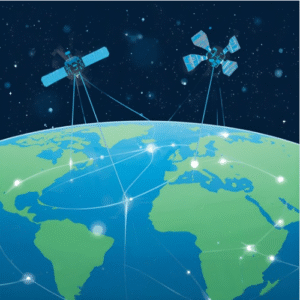Introduction to Communication Technology
Communication technology plays a vital role in shaping how we interact, exchange ideas, and access information. Over time, it has evolved from simple tools and techniques to sophisticated systems that connect people across vast distances. This transformation has been driven by the need for faster, more efficient, and accessible ways to communicate. Each new development has introduced innovative solutions to overcome the limitations of earlier methods, ultimately influencing not just personal communication but also industries, education, and global connectivity.
The progress of communication technology reflects humanity’s drive to stay connected. Early human societies relied on physical and visual methods to send messages. Over centuries, innovations emerged, solving the challenges posed by distance and time. As new systems replaced older ones, communication became increasingly convenient and efficient.

Today’s advancements, like digital networks and mobile devices, stand as milestones in a long history of technological achievements. These tools allow people to connect in ways that were once unimaginable, breaking barriers of geography and time. From enabling virtual meetings to supporting collaboration across continents, communication technology now plays a pivotal role in nearly every aspect of modern life.
Its evolution is marked by creativity and adaptation, as each stage reflects the changing needs of society. As we continue to rely on these technologies, the pace of development is only accelerating. New tools and platforms are constantly being introduced, offering innovative ways to share and access information. This dynamic field continues to shape how we connect, offering endless opportunities for growth and transformation.
Early Methods of Communication
In the earliest stages of human history, communication relied heavily on direct interaction and simple tools. Early communities developed techniques to share information that could transcend immediate, face-to-face interactions. Smoke signals, for example, were used to convey alerts or announcements over considerable distances, while drum beats served as a way to send coded messages between groups in regions like Africa and the Americas. These methods, though ingenious for their time, were largely dependent on environmental conditions and were limited in the complexity of the messages they could deliver.
As societies became more organized, the need for more sophisticated communication methods grew. The use of messenger systems, such as runners or trained animals like pigeons, emerged to address the limitations of earlier practices. Messenger pigeons were particularly valuable, offering a relatively fast way to send written notes or commands over long distances. However, these systems still faced challenges, such as reliability and the time it took for messages to travel.
The advent of written language brought about a significant shift in communication. Carving messages into stone or etching symbols onto clay tablets allowed communities to preserve and share ideas in a more permanent way. This later evolved into the use of papyrus, parchment, and paper, which made it possible to send written correspondence across wider areas. Letters became a cornerstone of communication for centuries, providing an essential means for governments, businesses, and individuals to share information. While the speed of delivery depended on the available transportation methods, written communication was more precise and reliable than earlier systems.
In addition to writing, certain regions developed other forms of symbolic communication, such as nautical flag signaling or the use of beacon fires to relay urgent messages. These techniques underscored humanity’s resourcefulness in overcoming the challenges posed by geography and limited technology.

The Telegraph and Telephone Era
The 19th century witnessed groundbreaking progress in communication technology with the development of the telegraph. This device allowed messages to be sent over long distances using electrical signals, fundamentally altering the speed at which information could travel. Unlike earlier methods that relied on physical transportation, the telegraph made near-instantaneous communication possible, which was especially critical for businesses, governments, and individuals seeking timely updates.
The introduction of Morse code, a system of dots and dashes representing letters and numbers, became an essential aspect of telegraphy. Operators used this code to transmit messages across networks of wires, creating a faster and more efficient way to share information. By the mid-19th century, telegraph lines spanned continents, and the establishment of the transatlantic cable in 1858 enabled communication between North America and Europe, connecting the world like never before.
Building on the foundation laid by the telegraph, the invention of the telephone in 1876 by Alexander Graham Bell took communication to an entirely new level. For the first time, people could hear each other’s voices from miles away, adding a personal dimension that the telegraph lacked. The telephone initially required a network of operators to connect calls manually, but as technology advanced, automated switching systems made it possible to place calls directly without operator assistance.
The telephone rapidly gained popularity, transforming from a luxury item to a common household device within a few decades. It became indispensable for both personal and professional communication, facilitating instant conversations that were far more interactive and natural than written messages. The widespread adoption of the telephone also paved the way for further innovations, such as long-distance and international calling, solidifying its place as one of the most significant achievements in communication technology.

The Rise of the Internet
The internet revolutionized how people communicate by introducing entirely new ways to interact and share information. With the ability to send messages instantly and access vast amounts of knowledge, it quickly became a cornerstone of modern communication. Email became one of the earliest and most widespread tools, allowing users to send detailed messages across the globe in seconds. This replaced many traditional forms of written correspondence, streamlining both personal and professional interactions.
Instant messaging emerged as another pivotal development, offering real-time exchanges that were quicker and more dynamic than emails. Early platforms like ICQ and AOL Instant Messenger allowed users to chat live, while forums and chat rooms created online communities where people could connect based on shared interests. These spaces became virtual meeting points, giving rise to entirely new forms of social interaction.
The internet also facilitated the sharing of multimedia content. With the introduction of websites and file-sharing platforms, users could distribute images, videos, and documents across a global audience. This shift marked the beginning of a digital age where communication was no longer limited to text alone. Voice-over-IP services like Skype later allowed individuals to make voice and video calls over the internet, further diversifying the ways people could connect.
In addition to person-to-person interaction, the internet introduced the concept of mass communication through the creation of blogs, news websites, and social platforms. Individuals and organizations could now broadcast information to vast audiences without the need for traditional publishing or broadcasting systems. This democratization of information transformed industries such as media, marketing, and education, giving people the ability to access and contribute to a global exchange of ideas.

As broadband connections became more widespread, the internet’s role expanded, integrating itself into nearly every aspect of life. The continuous development of online platforms further pushed the boundaries of communication, fostering a digital culture that reshaped how individuals, businesses, and societies interact.
Mobile Technology and Social Media
The advent of mobile technology transformed the landscape of communication by enabling constant connectivity. Smartphones, equipped with internet access, advanced cameras, and a range of applications, became indispensable tools for staying in touch and sharing content. Unlike earlier communication devices, smartphones offered a seamless integration of various features, such as messaging, calling, browsing, and media sharing, all within a single portable device.
Social media platforms further expanded the possibilities of mobile communication by creating spaces where users could interact, engage, and share in real time. These platforms have reshaped the way people form and maintain relationships, often replacing traditional modes of interaction. The rise of mobile apps like WhatsApp, Snapchat, and Instagram made it easier for users to send multimedia messages instantly, fostering more dynamic and engaging exchanges.
The integration of social media with mobile technology allowed for unprecedented access to global communities. People could now follow events as they happened, participate in conversations on a global scale, and share their personal experiences with large audiences. Mobile technology also empowered individuals to create and consume content anywhere, removing the limitations of physical location.

Businesses quickly recognized the potential of these tools, leveraging mobile-friendly platforms for marketing, customer engagement, and brand building. Features like live streaming and stories created new opportunities for companies to connect with their audience in authentic and immediate ways. Mobile technology has also enhanced the role of influencers, who rely on social media to build their presence and engage with followers.
The shift to mobile-first communication has not only changed personal interactions but also influenced societal trends. Activism, awareness campaigns, and social movements have increasingly relied on mobile technology to organize and reach broader audiences. This dynamic shift has ensured that mobile technology and social media remain central to how modern societies communicate, share ideas, and access information.
Future Trends in Communication Technology
The future of communication technology is being shaped by groundbreaking advancements that promise to redefine how people interact. Artificial intelligence (AI) is becoming increasingly integrated into communication tools, enabling more efficient and tailored interactions. AI-powered chatbots and virtual assistants are already streamlining customer service and business communication, while natural language processing continues to improve the way humans and machines converse. Additionally, predictive algorithms are enhancing messaging platforms by offering context-aware suggestions and translations in real time.

Virtual reality (VR) and augmented reality (AR) are also making significant strides in transforming communication. These technologies offer immersive experiences that go beyond text, voice, or video. VR environments are paving the way for virtual meetings where participants can feel as though they’re in the same space, while AR applications allow real-time overlays of information onto the physical world. This has applications in fields ranging from education and healthcare to entertainment and remote work, enabling more interactive and impactful exchanges.
Another transformative development is the expansion of 5G networks, which are expected to deliver unprecedented speed and connectivity. By significantly reducing latency, 5G will support the widespread use of high-bandwidth applications, such as high-definition video streaming, multi-user VR environments, and advanced IoT devices. This technology will facilitate seamless communication even in data-intensive scenarios, making interactions faster and more reliable.
Emerging technologies like brain-computer interfaces (BCIs) are also on the horizon, pushing the boundaries of what is possible in human communication. BCIs aim to allow direct communication between the brain and external devices, potentially enabling users to share thoughts and ideas without the need for spoken or written words. As research in this area progresses, it could lead to entirely new ways of connecting and exchanging information, radically changing how people communicate in the years to come.

Conclusion
The journey of communication technology reflects humanity’s enduring quest to overcome barriers and foster connections. Innovations throughout history have consistently transformed the way people share ideas, whether through groundbreaking tools like the telegraph and telephone or modern advancements such as the internet and mobile devices. Each step forward has addressed the challenges of its time, paving the way for greater efficiency, accessibility, and interaction.
Today, communication technology is woven into the fabric of daily life, enabling global collaboration, instant updates, and richer exchanges than ever before. Its integration with emerging technologies like artificial intelligence and virtual reality hints at a future where communication becomes even more intuitive and immersive. These advancements not only enhance personal interactions but also create opportunities to revolutionize industries, education, and social systems.
As society continues to embrace these changes, the potential for further innovation remains vast. The dynamic evolution of communication tools offers a glimpse into a world where distance and time are no longer barriers to meaningful connections. Whether through enhanced digital platforms or entirely new technologies, the drive to improve how we communicate will continue to shape the way we interact, work, and engage with the world around us.
